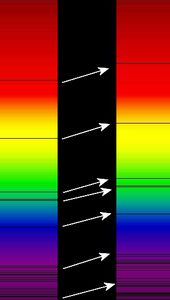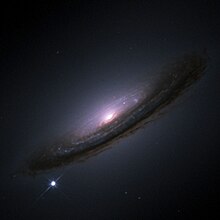by Ann » Sun Nov 13, 2011 7:03 am
Different methods are used to estimate the distance to galaxies.

The most popular method is redshift. The universe is expanding at a rate that is quite well known, and as the universe is expanding, it carries the galaxies with it. The light that reaches us from a galaxy will be "stretched", or redshifted, by an amount that is proportional to how much the universe has expanded since the light that reaches us from this galaxy was emitted. This method usually works very well, but it can't be reliably used for a galaxy like M83, which is too nearby. Galaxies have their own specific movement independent of the expansion of the universe, and this specific movement causes a Doppler shift. For a galaxy that is far away the Doppler shift is negligible compared with the redshift, but for galaxies that are much closer the Doppler shift may be so large compared with the redshift that the redshift can't be realiably used to infer the distance. Here the specific motion of the galaxy itself may either amplify or counteract the Hubble redshift.

A method that works quite well for nearby galaxies is to search for Cepheid variables. These are variable stars whose period, which can be easily measured, is directly linked to the absolute luminosity of these stars. By measuring how fast or slowly a Cepheid variable is pulsating, you can infer how bright it is. And by comparing how bright the star appears to be, compared with how bright it is known to be, you can work out the distance. There may conceivably be a problem if the galaxy is very dusty and the Cepheids are dust-reddened in such a way that it is hard to know how bright they really are. However, this problem should be solved by photographing the Cepheid through several filters to work out how reddened it is.

A third method that works well is to find a supernova type Ia in the galaxy and measure how bright it gets. Supernovae type Ia are "standard candles", whose absolute peak luminosity is known. M83 is actually a supernova factory, which has produced six supernovae since 1923. However, the latest supernova seen in M83 was, interestingly in view of the Messier number of this galaxy, in '83 - in 1983, that is. That was 28 years ago, and due to the southerly declination of this galaxy, it is likely that the supernova wasn't well observed back then. After all, even the supernova that was seen in the Large Magellanic Cloud four years later, Supernova 1987A, wasn't as well observed as it might have been.
http://en.wikipedia.org/wiki/Messier_83 wrote:
It was discovered by Ian Shelton and Oscar Duhalde at the Las Campanas Observatory in Chile on February 24, 1987, and within the same 24 hours independently by Albert Jones in New Zealand.
A bright naked-eye supernova shouldn't have to be independently discovered within the same 24 hours by anybody. In the 1980s, the astronomical community was not on the alert for new supernovae in the same way that it is today. As for the supernovae of M83, chances are that it is not really known if any of the supernovae in this galaxy were of type Ia. It is also possible that the supernovae weren't sufficiently well measured to have their peak brightness established without a doubt. Therefore it is likely that these supernovae can't be used as distance indicators.
There are other methods that can be used as distance indicators. As normal stars age, they will follow an evolutionary track that puts them in a position whose absolute luminosity is relatively well known, the so-called "red clump". In these color-magnitude diagrams, you can see stars located at the "red clump".
You can also search for stars that are located "at the tip of the red giant branch", the brightest red giants, whose luminosity is also relatively well known.
There are still more methods that can be used, such as searching for planetary nebulae and measuring how bright they appear to be, compared with how bright they may be assumed to be. But all in all, the distance to M83 is still "estimated". According to
http://en.wikipedia.org/wiki/Messier_83, the estimated distance to M83 is 14.7 million light years.
Ann
Different methods are used to estimate the distance to galaxies.
[float=right][img]http://upload.wikimedia.org/wikipedia/commons/thumb/1/14/Redshift.png/170px-Redshift.png[/img][/float]The most popular method is redshift. The universe is expanding at a rate that is quite well known, and as the universe is expanding, it carries the galaxies with it. The light that reaches us from a galaxy will be "stretched", or redshifted, by an amount that is proportional to how much the universe has expanded since the light that reaches us from this galaxy was emitted. This method usually works very well, but it can't be reliably used for a galaxy like M83, which is too nearby. Galaxies have their own specific movement independent of the expansion of the universe, and this specific movement causes a Doppler shift. For a galaxy that is far away the Doppler shift is negligible compared with the redshift, but for galaxies that are much closer the Doppler shift may be so large compared with the redshift that the redshift can't be realiably used to infer the distance. Here the specific motion of the galaxy itself may either amplify or counteract the Hubble redshift.
[float=left][img]http://www-outreach.phy.cam.ac.uk/resources/images/cepheid1.jpg[/img][/float]A method that works quite well for nearby galaxies is to search for Cepheid variables. These are variable stars whose period, which can be easily measured, is directly linked to the absolute luminosity of these stars. By measuring how fast or slowly a Cepheid variable is pulsating, you can infer how bright it is. And by comparing how bright the star appears to be, compared with how bright it is known to be, you can work out the distance. There may conceivably be a problem if the galaxy is very dusty and the Cepheids are dust-reddened in such a way that it is hard to know how bright they really are. However, this problem should be solved by photographing the Cepheid through several filters to work out how reddened it is.
[float=right][img]http://upload.wikimedia.org/wikipedia/commons/thumb/a/a2/SN1994D.jpg/220px-SN1994D.jpg[/img][/float]A third method that works well is to find a supernova type Ia in the galaxy and measure how bright it gets. Supernovae type Ia are "standard candles", whose absolute peak luminosity is known. M83 is actually a supernova factory, which has produced six supernovae since 1923. However, the latest supernova seen in M83 was, interestingly in view of the Messier number of this galaxy, in '83 - in 1983, that is. That was 28 years ago, and due to the southerly declination of this galaxy, it is likely that the supernova wasn't well observed back then. After all, even the supernova that was seen in the Large Magellanic Cloud four years later, Supernova 1987A, wasn't as well observed as it might have been. http://en.wikipedia.org/wiki/Messier_83 wrote:
[quote]It was discovered by Ian Shelton and Oscar Duhalde at the Las Campanas Observatory in Chile on February 24, 1987, and within the same 24 hours independently by Albert Jones in New Zealand.[/quote]
A bright naked-eye supernova shouldn't have to be independently discovered within the same 24 hours by anybody. In the 1980s, the astronomical community was not on the alert for new supernovae in the same way that it is today. As for the supernovae of M83, chances are that it is not really known if any of the supernovae in this galaxy were of type Ia. It is also possible that the supernovae weren't sufficiently well measured to have their peak brightness established without a doubt. Therefore it is likely that these supernovae can't be used as distance indicators.
[float=left][img2]http://www.aanda.org/index.php?option=com_image&format=raw&url=/articles/aa/full_html/2009/29/aa11465-08/img19.png[/img2][/float]There are other methods that can be used as distance indicators. As normal stars age, they will follow an evolutionary track that puts them in a position whose absolute luminosity is relatively well known, the so-called "red clump". In these color-magnitude diagrams, you can see stars located at the "red clump".
You can also search for stars that are located "at the tip of the red giant branch", the brightest red giants, whose luminosity is also relatively well known.
There are still more methods that can be used, such as searching for planetary nebulae and measuring how bright they appear to be, compared with how bright they may be assumed to be. But all in all, the distance to M83 is still "estimated". According to http://en.wikipedia.org/wiki/Messier_83, the estimated distance to M83 is 14.7 million light years.
Ann